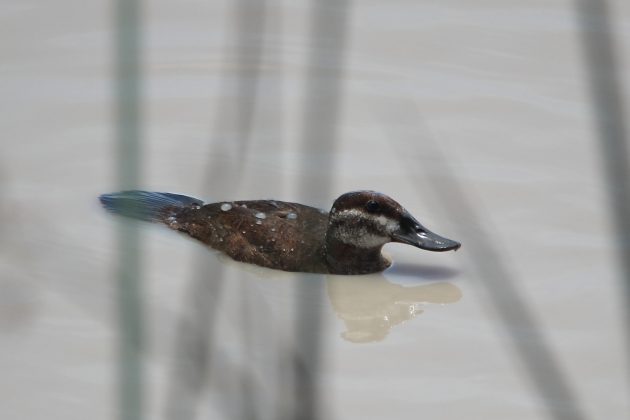Oxford Languages defines a bluenose as a “priggish or puritanical” person. Oddly enough, it can also refer to a person from Nova Scotia. I imagine that this is due to the cold winters up there, rather than suggesting that all Nova Scotians are prudes.
But for birders, the name bluenose might more easily be applied to ducks of the genus Oxyura. The six species in this genus are all distinguished by having stiff tail feathers, often held upright in a sort of butt-salute, and by the males sporting an even more improbable bright blue bill during the breeding season. To my taste, this makes these birds among the most endearing ducks out there.
The North American representative of this genus is the Ruddy Duck, Oxyura jamaicensis. It is usually an easily-seen resident on the deeper sections Lake Cuitzeo, a half hour from my home. But over the past year, almost all of the lake dried up, and what little water remained was only inches deep. So this diving duck fled to whatever deeper lakes remained; during the first half of 2024 I only managed to see a handful on nearby Lake Queréndaro. Happily, our monsoon rains have come in beautifully this summer, and this week a trip to see Lake Cuitzeo’s progress revealed a group of three Ruddy Ducks on its newly deepening waters.. Even better, one of the three was a respendent male with, yes, a bright blue bill.
The still-low water levels had pushed these three ducks closer to the highway from which I can observe them, so these are my best photos to date of a breeding male. On earlier occasions I had often appreciated their bright bills and stiff tails, as these are easily seen even at a distance, and in any lighting. But this was the first time that closeness and good light allowed me to appreciate the deep reddish-brown color that give the Ruddy Duck its name.

And yes, each and every one of my photos (I took around 100) showed beads of the lake’s rather muddy water on the backs of these ducks. It looked as if someone had dripped hot glue on them. Water usually sheets off the backs of most ducks, but the Ruddy Duck’s back apparently holds the water in place. (Check out the drop stuck to the duck’s forehead in this picture.)

During the winter, male Ruddy Ducks lose their bright blue bills. I guess it is exhausting to maintain such sartorial finery.

This is a winter male. For obvious reasons, it is the only photo not from this week.
As I mentioned above, two more individuals swam near Monday’s lone adult male. Their behavior indicated that the three formed a family unit.

Ruddy Duck #2

Ruddy Duck #3
Unfortunately, there is no way to know whether these two were females, or immature males. If these bluenoses are indeed puritanical and priggish, I certainly hope they were not a threesome.

Source link

